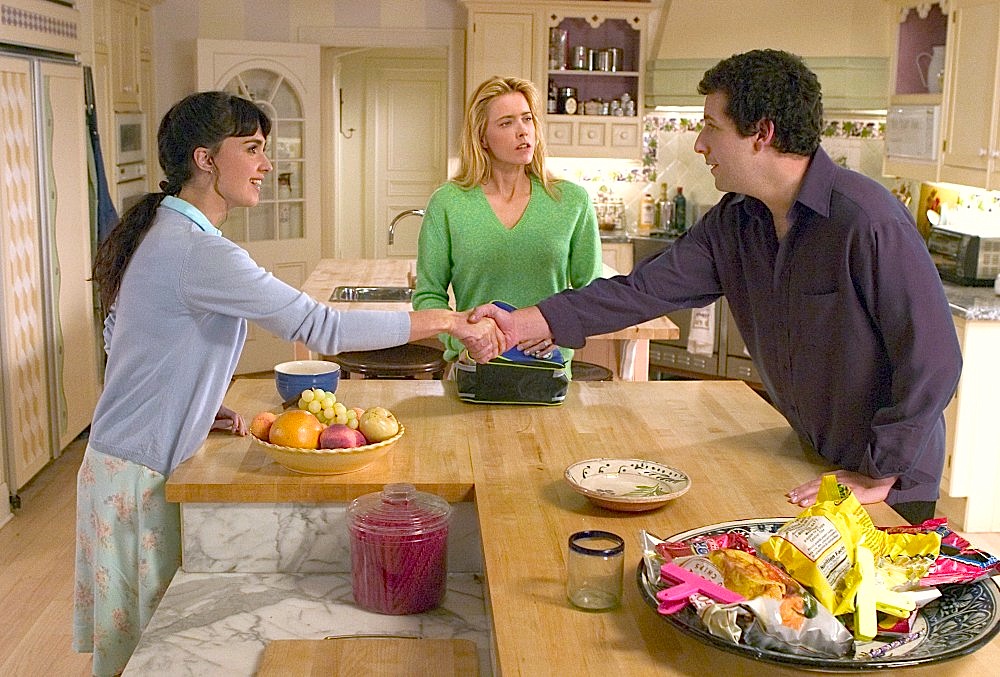MARIANI’S
Virtual Gourmet
June 21,
2020
NEWSLETTER
❖❖❖
IN THIS ISSUE
TAPAS AND DINNER
IN THE BASQUE COUNTRY
By John Mariani
NEW YORK CORNER
LOVE AND PIZZA
Chapter Thirteen
By John Mariani
NOTES FROM THE WINE CELLAR
MILLBROOK WINERY
By Geoff Kalish
❖❖❖
TAPAS AND DINNER
IN THE BASQUE COUNTRY
By John Mariani
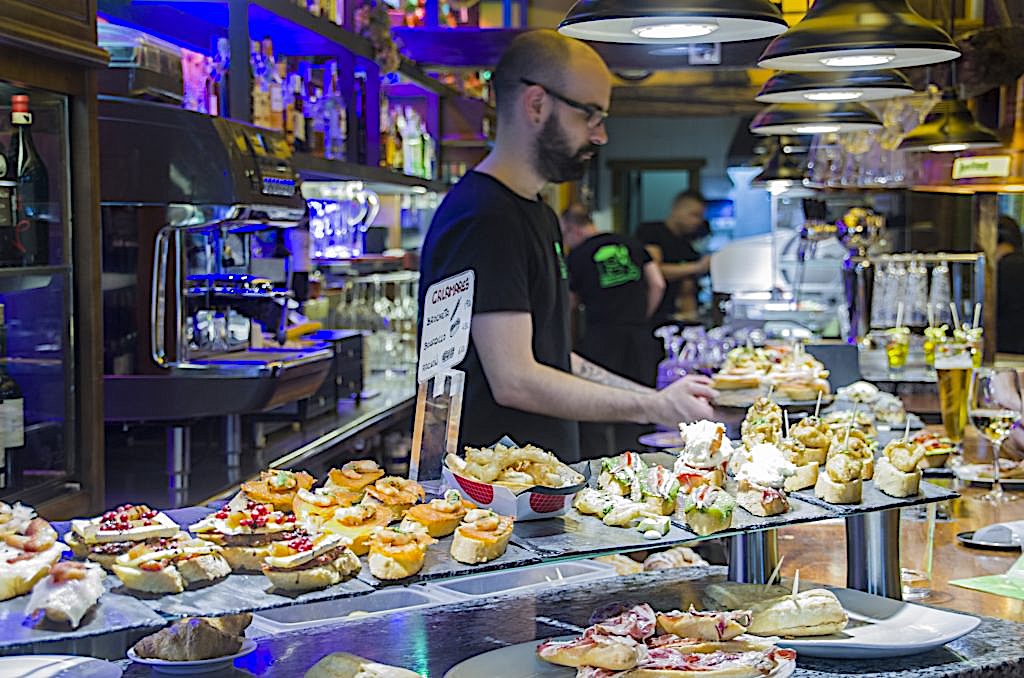
Berton in Bilbao
The
news that Spain’s restaurants are now open—with
reduced capacity and social distancing—makes the
prospect of visiting all the more savory at this
time, when deprivation makes the appetite roar.
It might well be said that the way people eat in
Spain is the way the rest of the world is now
eating. Not that Spanish foods like salt cod,
paella, and garlic soup are showing up on global
menus, but that the flavors of Spain’s
cuisine—sweet peppers, beans, ham, shellfish,
and the idea of tapas—have become part of the
repertoire of chefs from Portland to Paris.
Spanish wines are now considered among the
finest in the world, and the explosion of media
attention given to Spain’s “molecular cuisine” has
cooled down and never had much to do with the way
Spaniards actually love to eat, according to
revered regional traditions.
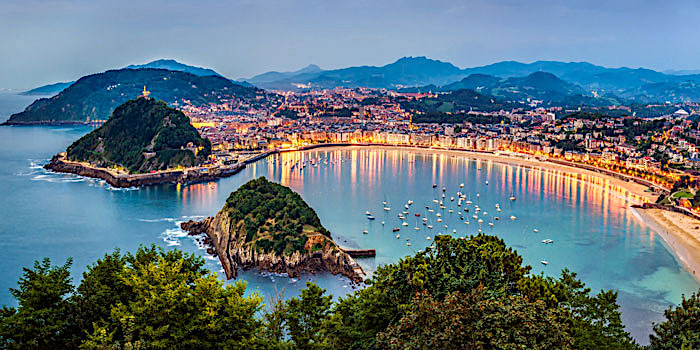 Nowhere
is this more distinctive than in the Basque
country of Northern Spain, especially in the
seaside city of San Sebastian (left) and the
surging cultural capital of Bilbao and La Rioja
Alta. The Basque country, stretching from the
French border westward to Cantabria and south to
Burgos, is only 4,500 square miles of territory,
and you can’t drive more than three hours in any
direction without crossing into another province.
It is richly indebted to foods from the Cantabrian
Sea: chipirones
(baby squid), ventresca
(tuna belly), rodaballo
(turbot), gambas
(shrimp), merluza (hake),
kokotxas
(hake cheeks),
bacalao
(cod), almejas, (clams), txangurro
(spider-crab), cigalas (langoustines),
and the famous—and very expensive--angulas
(baby eels), found in the estuaries of the Bay of
Biscay.
Nowhere
is this more distinctive than in the Basque
country of Northern Spain, especially in the
seaside city of San Sebastian (left) and the
surging cultural capital of Bilbao and La Rioja
Alta. The Basque country, stretching from the
French border westward to Cantabria and south to
Burgos, is only 4,500 square miles of territory,
and you can’t drive more than three hours in any
direction without crossing into another province.
It is richly indebted to foods from the Cantabrian
Sea: chipirones
(baby squid), ventresca
(tuna belly), rodaballo
(turbot), gambas
(shrimp), merluza (hake),
kokotxas
(hake cheeks),
bacalao
(cod), almejas, (clams), txangurro
(spider-crab), cigalas (langoustines),
and the famous—and very expensive--angulas
(baby eels), found in the estuaries of the Bay of
Biscay.
The farms around
Gernika provide wonderful pimientos and kidney
beans, mushrooms and potatoes. The sheep’s milk
Idiazabal cheese (once smoked in chimneys) has a
distinctive wild gaminess. Spanish hams are
nonpareil, and the lamb is as redolent of whatever
it feeds on.
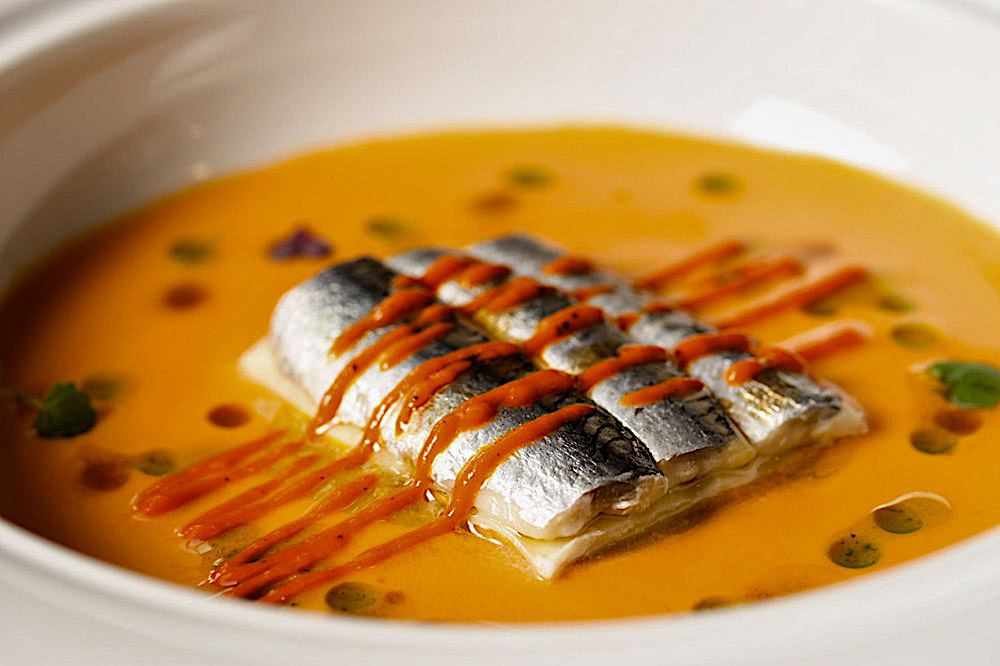
People go to old cider houses to drink the
fresh, slightly alcoholic apple juice. And the
regional wines, including the fine red Rioja
Alavesa and the sparkling Txakoli, go perfectly
with hearty Basque cooking.
The easiest way to begin sampling all these
foods and wines is at the ubiquitous tapas bars,
called tascas. Most
nights in the casco viejo
(old quarter) of the gorgeous city of San
Sebastián, which arcs around the Bay of Biscay,
the bars are packed with locals who come to snack
on tapas—called pinchos—and
to drink red and rosé wines, cider, Mahou beer, or
Txakoli. The prowl from bar to bar is called el txikito,
referring to the squat, wide-mouthed glasses
drinks are served in.
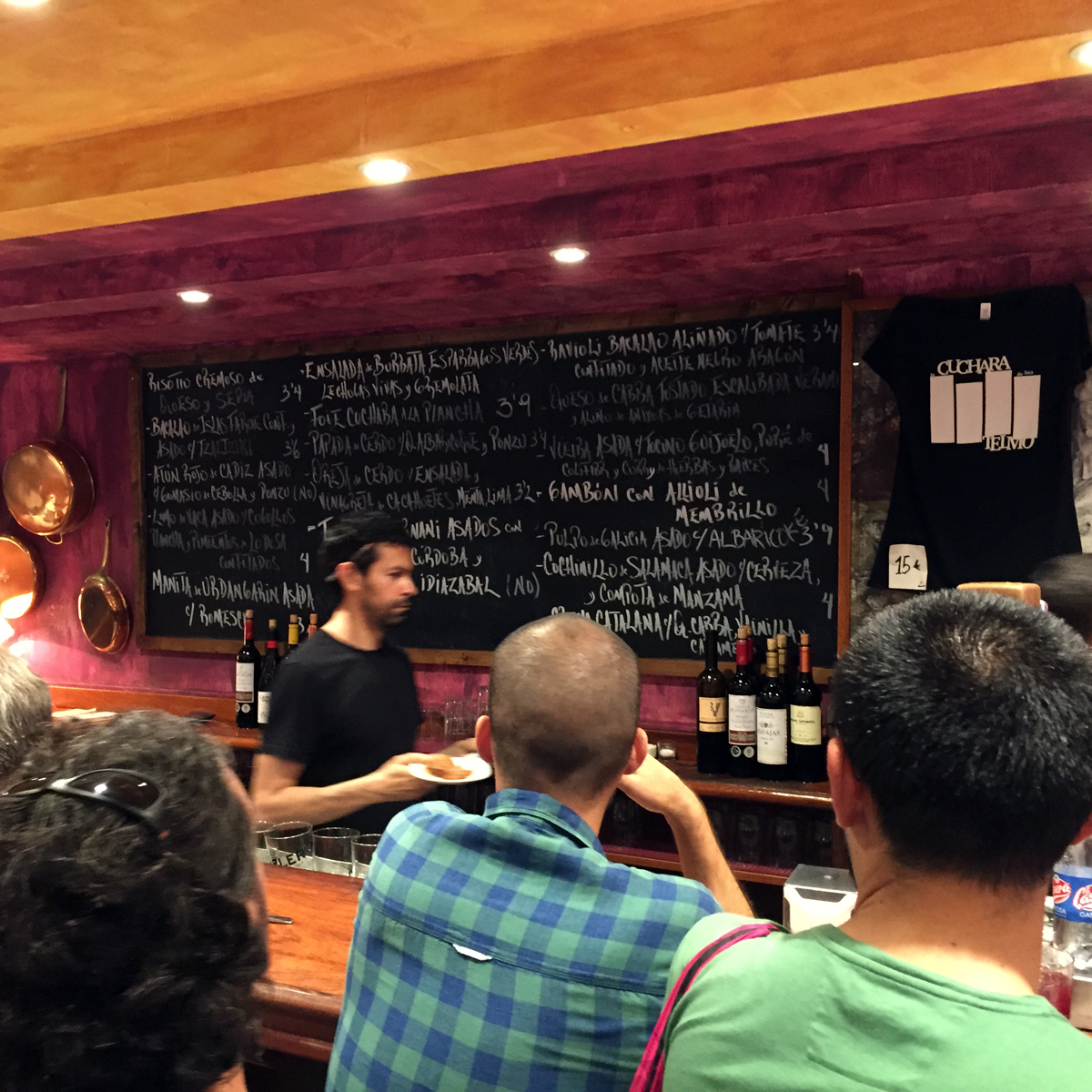 The
array of tapas. listed on a blackboard, at
some bars may number thirty or more, though most
places serve perhaps twenty, some hot, some cold,
and are quite similar from bar to bar. You
always find thin, silky slices of Spanish ham on
crusty bread (good bread is a distinguishing
factor among tapas bars); scrambled eggs and
mushrooms; sardines and anchovies; stuffed
pimientos; fried croquetas;
and a potato omelet called tortilla de
patata. Everything is unstintingly fresh: in
a good
tasca those pinchos
made in the morning and not consumed by the
afternoon are discarded and new ones prepared for
the evening.
The best way to tell a good tapas bar from
a poor one among more than 500 in San Sebastián is
to measure the square footage you can manage to
occupy on the floor. Anything more than one square
foot means the bar is not very popular, and
jostling for a position near the bar itself is
part ritual and part endurance test.
The
array of tapas. listed on a blackboard, at
some bars may number thirty or more, though most
places serve perhaps twenty, some hot, some cold,
and are quite similar from bar to bar. You
always find thin, silky slices of Spanish ham on
crusty bread (good bread is a distinguishing
factor among tapas bars); scrambled eggs and
mushrooms; sardines and anchovies; stuffed
pimientos; fried croquetas;
and a potato omelet called tortilla de
patata. Everything is unstintingly fresh: in
a good
tasca those pinchos
made in the morning and not consumed by the
afternoon are discarded and new ones prepared for
the evening.
The best way to tell a good tapas bar from
a poor one among more than 500 in San Sebastián is
to measure the square footage you can manage to
occupy on the floor. Anything more than one square
foot means the bar is not very popular, and
jostling for a position near the bar itself is
part ritual and part endurance test.
The best tascas
offer a wider variety and several house
specialties.
One of the best is Gandarias
Jatetxea, which serves tripe, chorizo
sausage, several types of croquetas,
some with cod and a creamy béchamel inside, and
has exclusivity to carry Spain’s finest and most
expensive ham, from the producer Joselito.
My favorite tasca is
La Cuchara
de San Telmo (left). It is also the one with
the least wiggle room, so you will find yourself
cheek to jowl with locals‒although these days
there might be social distancing‒, who point to
the cold tapas on the bar or order the hot ones,
which on any given night might include shredded
oxtail, a risotto with blue Cabrales cheese, even
foie gras.
The tradition among barmen at the tascas is
to pour the wines by holding the bottle a good
foot away into the txikito glasses, and rarely do they
ever waste a drop. You get a short pour—maybe an
inch or two, the reason being that most people eat
one or two tapas, slug down their drink, and move
on. My own preference is to drink the cold, fizzy
Txakoli, whose alcohol is only about 10-11.5
percent. That way I don’t wobble (much) down the
street after my third tasca
visit.
From San Sebastian you can drive, as I
recently did, west on Route N634 along the
rippling seacoast, through  small
cities and tiny towns, many with ancient Basque
names that contain those identifying x’s and z’s
within their spelling. Less than an hour from San
Sebastián is the wonderful old, cobblestoned
fishing town of Getaria, cuddled around a snug
harbor dotted with seafood restaurants, where what
you will eat is what just came up from the docks
that morning.
small
cities and tiny towns, many with ancient Basque
names that contain those identifying x’s and z’s
within their spelling. Less than an hour from San
Sebastián is the wonderful old, cobblestoned
fishing town of Getaria, cuddled around a snug
harbor dotted with seafood restaurants, where what
you will eat is what just came up from the docks
that morning.
The prettiest
perch is at Kaia-Kaipe (right), a
restaurant above the harbor, with an extensive
menu that includes the velvety bacalao
dish called pil-pil,
made by combining olive oil and garlic with
cod until it becomes like mayonnaise. But my
favorite place is Iribar,
catty corner to Getaria’s San Salvador Church.
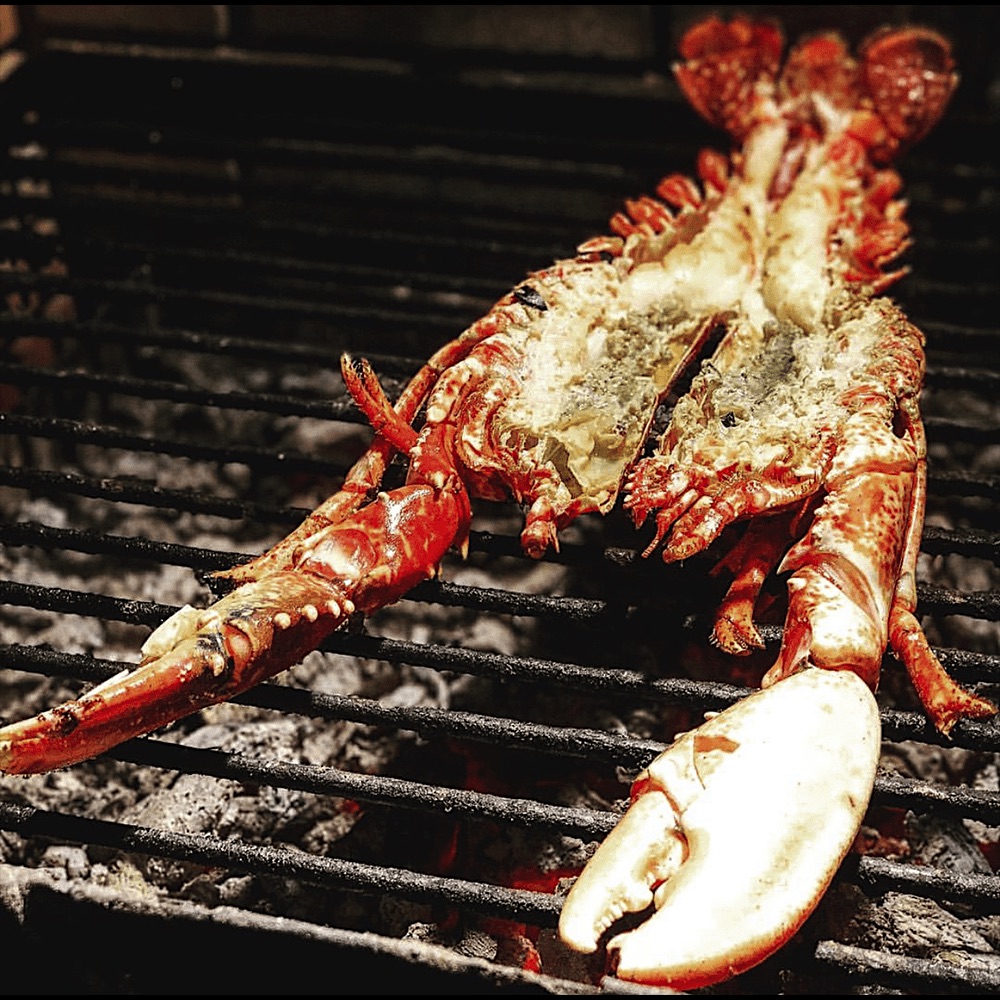 My wife and I sat on the
mezzanine, watching people drift in after one
o’clock for lunch.
The large menu is built around the day’s
fish, so we ordered a lustrous and tender octopus
salad, quickly grilled prawns glossy with olive
oil, and rodaballo
(turbot),
which, like all the fish, is grilled over an
outdoor charcoal grill, the fish moistened with
frequent sprinklings of olive oil, white wine, and
garlic. Lobster on the grill is remarkably well
priced (left).
My wife and I sat on the
mezzanine, watching people drift in after one
o’clock for lunch.
The large menu is built around the day’s
fish, so we ordered a lustrous and tender octopus
salad, quickly grilled prawns glossy with olive
oil, and rodaballo
(turbot),
which, like all the fish, is grilled over an
outdoor charcoal grill, the fish moistened with
frequent sprinklings of olive oil, white wine, and
garlic. Lobster on the grill is remarkably well
priced (left).
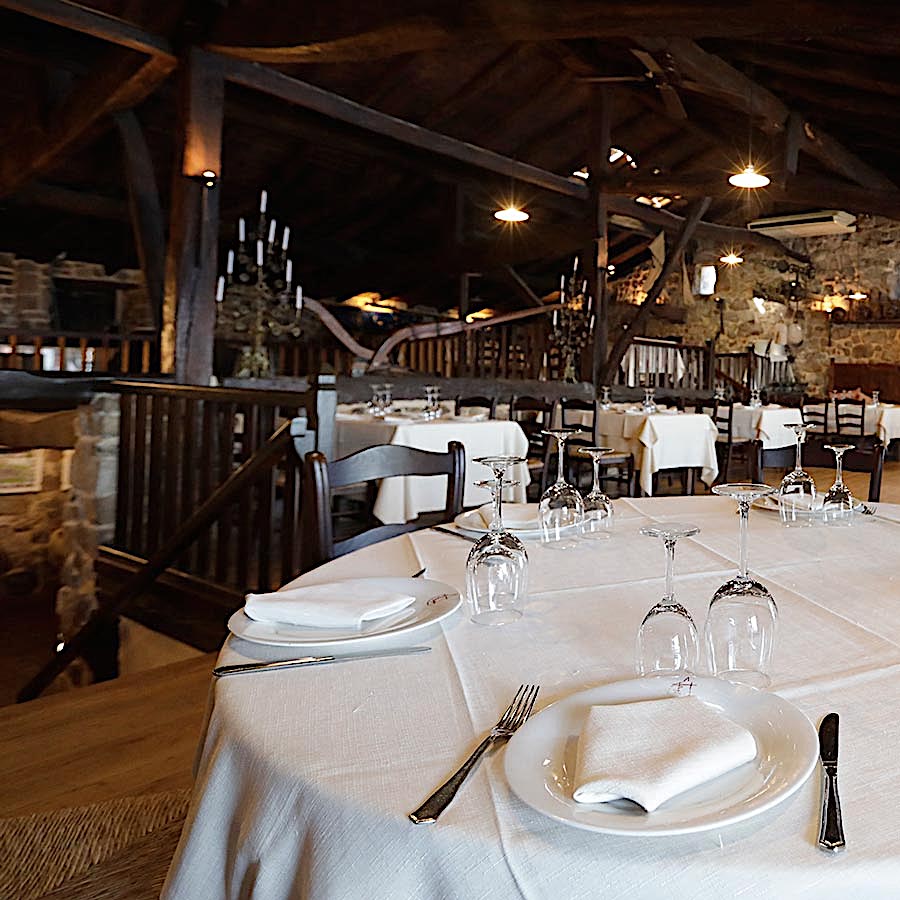
Farther west, we found Eneperi
Jatetxea (right)
off a hairpin turn along the swerving coast road
between Bakio and Bermeo. Timbered
throughout with a barn-like roof, plenty
of sailor memorabilia—even a small museum of
marine artifacts—and waitresses in traditional
blouses and long skirts, this is a rustic and
beautiful restaurant (with a somewhat lax service
staff) that is clearly for either a business meal
or serious night out. The menu still holds to
regional cookery but with considerable flair in
dishes like green Basque peppers stuffed with
onion and pork, the moist tail of hake in a red
pepper sauce, and an ice cream made from fresh
cheese and walnuts with Chinese gooseberries.
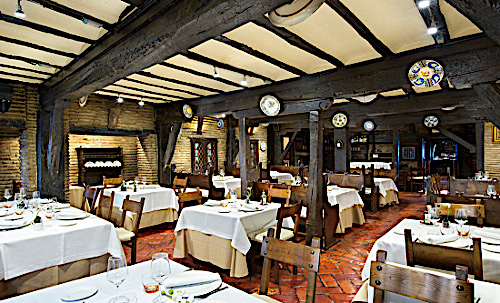 Eventually we
wound our way south through pine forests and tiny
towns like Eibar, Urkiola, and Durango to the
beautiful, broad city of Vitoria, called Gasteiz
in the Basque language. Bustling and modern, Vitoria
has been very careful to restore and maintain its
historic buildings, magnificent churches, and
green parks, and many streets are closed off to
motor traffic.
There we dined at one of the oldest
restaurants in northern Spain, El Portalón
(left),
hidden behind a nondescript door in
Eventually we
wound our way south through pine forests and tiny
towns like Eibar, Urkiola, and Durango to the
beautiful, broad city of Vitoria, called Gasteiz
in the Basque language. Bustling and modern, Vitoria
has been very careful to restore and maintain its
historic buildings, magnificent churches, and
green parks, and many streets are closed off to
motor traffic.
There we dined at one of the oldest
restaurants in northern Spain, El Portalón
(left),
hidden behind a nondescript door in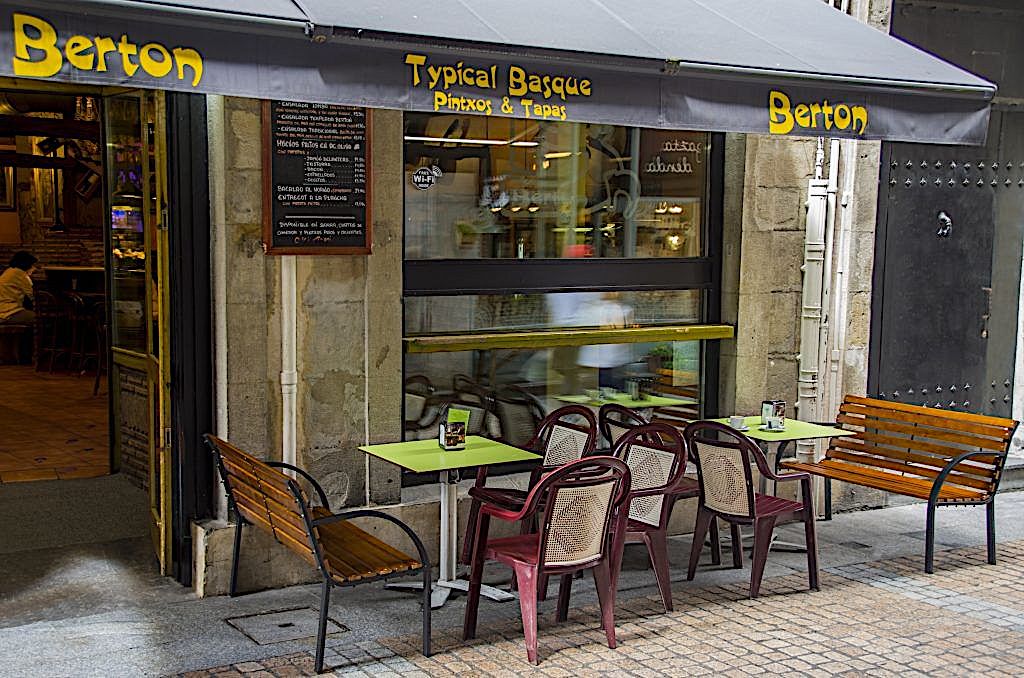 a three-story building dating to
the 15th century, inside a warren of varnished
staircases, rough wooden beams, tiled floors, and
antique artwork. The food is hearty and generous,
from a thick, red bean soup riddled with cabbage
and slices of blood sausage, to squid cooked in
its own ink with rice, and a platter of flavorful,
fatty morsels of oxtail with sliced fried
potatoes.
a three-story building dating to
the 15th century, inside a warren of varnished
staircases, rough wooden beams, tiled floors, and
antique artwork. The food is hearty and generous,
from a thick, red bean soup riddled with cabbage
and slices of blood sausage, to squid cooked in
its own ink with rice, and a platter of flavorful,
fatty morsels of oxtail with sliced fried
potatoes.
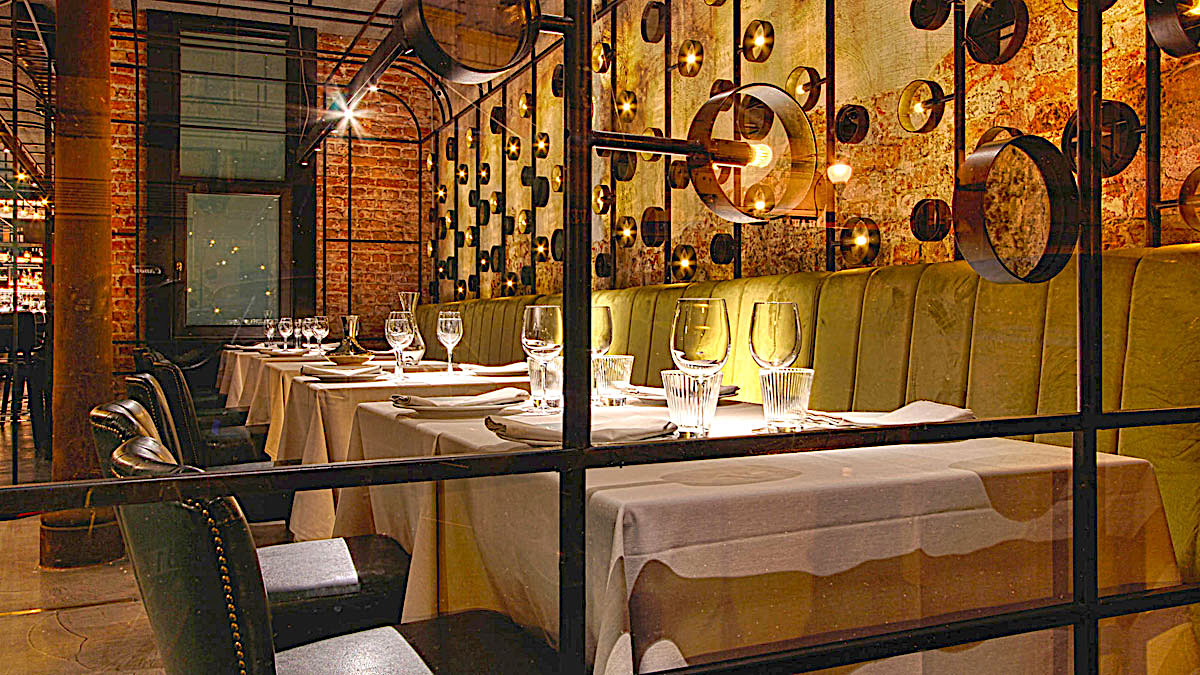 So
much has been written about modern,
tourist-overrun Bilbao that its Basque character
has been somewhat displaced. But you will still
find it in the spirit of restaurants and tapas
bars all over the youthful, fashionable city,
particularly across the river in the Old Town
around the Cathedral of Santiago, now teeming with
new tascas
and cafés. Berton
is one of the best new ones, known for its ham. On the
other side of the river, where all the new
cultural facilities are built, Restaurante
Etxanobe (left)
is located on the third floor of the striking
Palaçio de Congresos y de la Musica, looking out
over the city from glass walls. Well-spaced tables
and impeccable service lend a sophisticated
ambiance to the evening, which begins with
excellent breads and six different olive oils,
followed by grilled langoustines scented with
vanilla, and a red rockfish with orange—inventive
but not molecular, simple cooking with real flair.
So
much has been written about modern,
tourist-overrun Bilbao that its Basque character
has been somewhat displaced. But you will still
find it in the spirit of restaurants and tapas
bars all over the youthful, fashionable city,
particularly across the river in the Old Town
around the Cathedral of Santiago, now teeming with
new tascas
and cafés. Berton
is one of the best new ones, known for its ham. On the
other side of the river, where all the new
cultural facilities are built, Restaurante
Etxanobe (left)
is located on the third floor of the striking
Palaçio de Congresos y de la Musica, looking out
over the city from glass walls. Well-spaced tables
and impeccable service lend a sophisticated
ambiance to the evening, which begins with
excellent breads and six different olive oils,
followed by grilled langoustines scented with
vanilla, and a red rockfish with orange—inventive
but not molecular, simple cooking with real flair.
~~~~~~~~~~~~~~~~~~~~~~~~~
Here are a few more tips about bar
hopping in San Sebastian: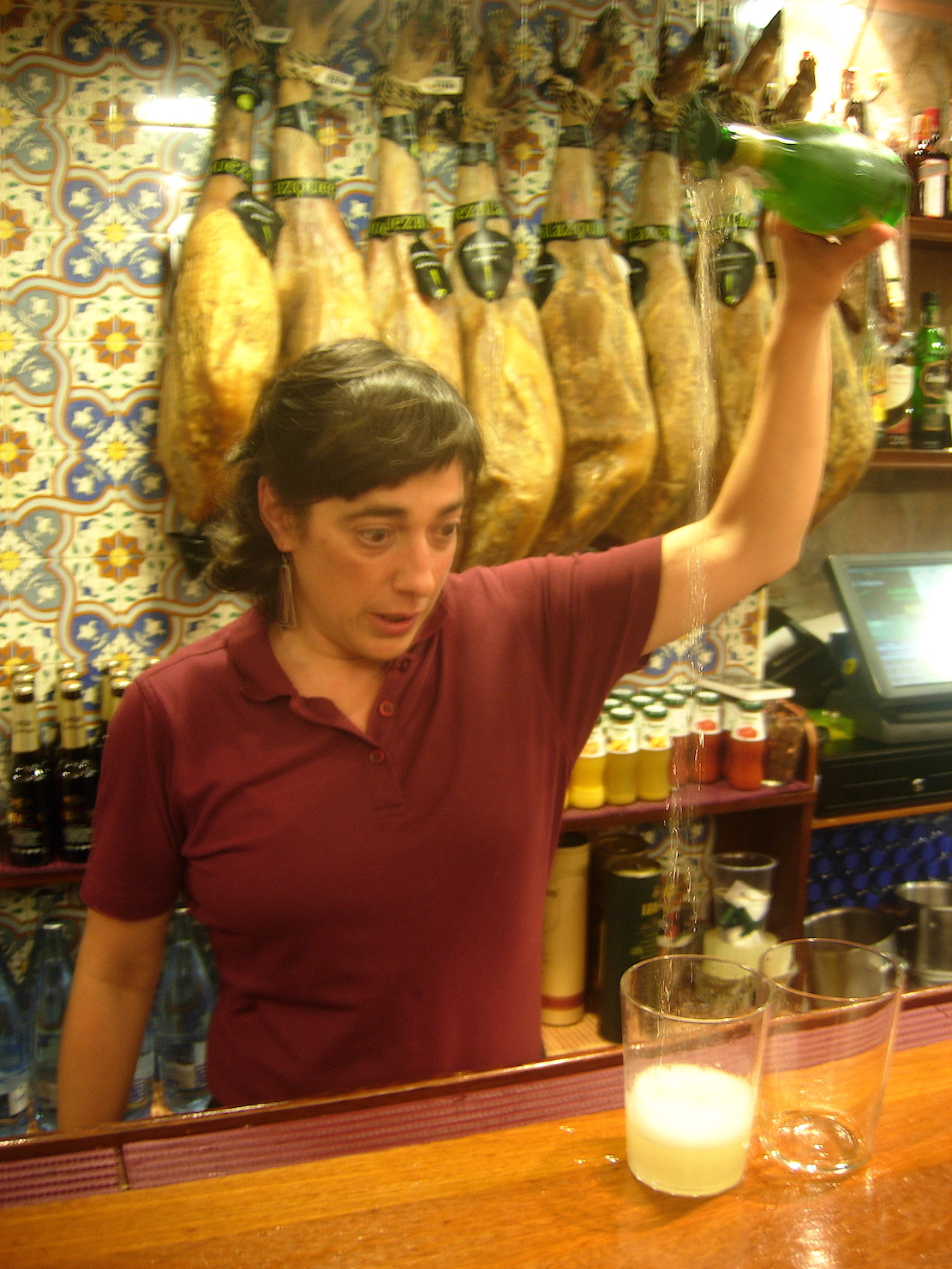
• There are
at least a dozen tapas bars (and restaurants)
along the Calle 31 de Agosto, and every hotel will
provide a map of them.• Cold items line
the bar, while hot dishes are listed on
blackboards.
• The barman
totals up the bill merely by looking at the empty
plates you return. It’s an honor system.
• There is
no tipping required in a tasca.
• The locals
tend to eat late, but not nearly as late as they
do in Madrid. Start bar hopping after 8 p.m. and
the tascas will be swarming by 9. During the week
they start to close up around midnight, later on
weekends.
RESTAURANTS
Gandarias Jatetxea--Calle 31
Calle de Agosto 23, San Sebastián; www.restaurantegandarias.com
La Cuchara de San Telmo--Calle 31
de Agosto, 28, San Sebastián.
www.labicidesantelmo.com
Irib0ar, Kale Nagusia Kalea, 34
Getaria. www.iribargetaria.com
El Portalón—151 Correria,
Vitoria; www.restauranteelportalon.com
Kaia-Kaipe—General Arnao 4,
Getaria; www.kaia-kaipe.com
Eneperi Jatetxea—89 San Pelayo,
Bakio; www.eneperi.com.
Berton—11 Jardines, Bilbao;
https://www.berton.eus
Etxanobe—4 Avenue de
Abandoibarra, Bilbao; ladespensadeletxanobe.com
❖❖❖
By John Mariani
LOVE AND PIZZA
Since, for the time being, I am unable to write about or review New York City restaurants, I have decided instead to print a serialized version of my (unpublished) novel Love and Pizza, which takes place in New York and Italy and involves a young, beautiful Bronx woman named Nicola Santini from an Italian family impassioned about food. As the story goes on, Nicola, who is a student at Columbia University, struggles to maintain her roots while seeing a future that could lead her far from them—a future that involves a career and a love affair that would change her life forever. So, while New York’s restaurants remain closed, I will run a chapter of the Love and Pizza each week until the crisis is over. Afterwards I shall be offering the entire book digitally. I hope you like the idea and even more that you will love Nicola, her family and her friends. I’d love to know what you think. Contact me at loveandpizza123@gmail.com
—John Mariani
To read previous chapters go to archive (beginning with March 29, 2020, issue.
LOVE AND PIZZA
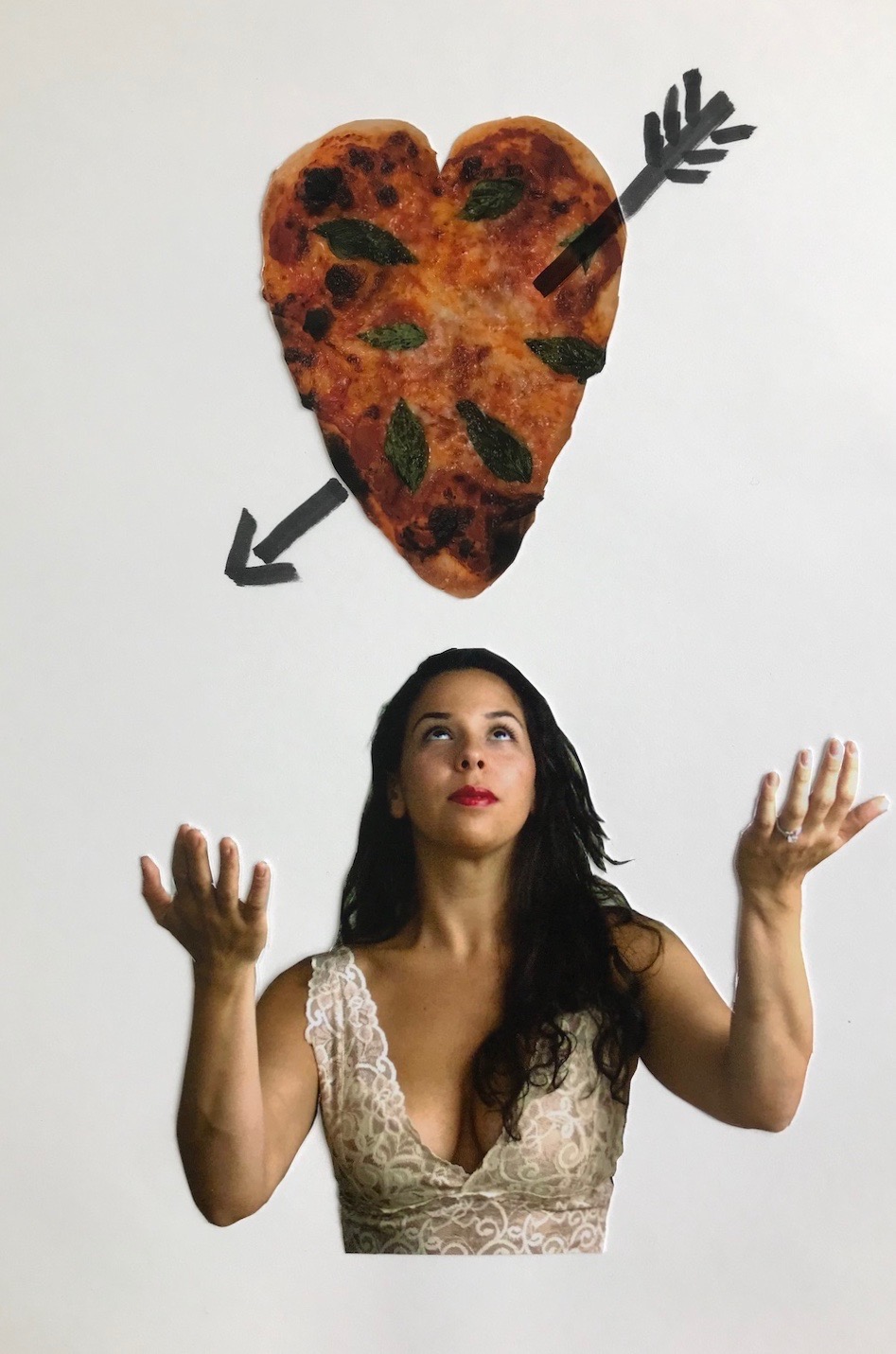
Cover Art By Galina Dargery
It
had been through an odd turn of fate and
fortune that Milan had become a major
fashion capital, when for decades it existed
in the shadow of far more elegant
cities like Rome and Florence. After World War
II, Florence, which had been a
major European textile center since the 14th
century, had come to dominate
Italian fashion through its production of
silks and leather goods made by
designers like the Ferragamo family, Gucci,
and the aristocratic Emilio Pucci (left)—all
Tuscans by birth and temperament.
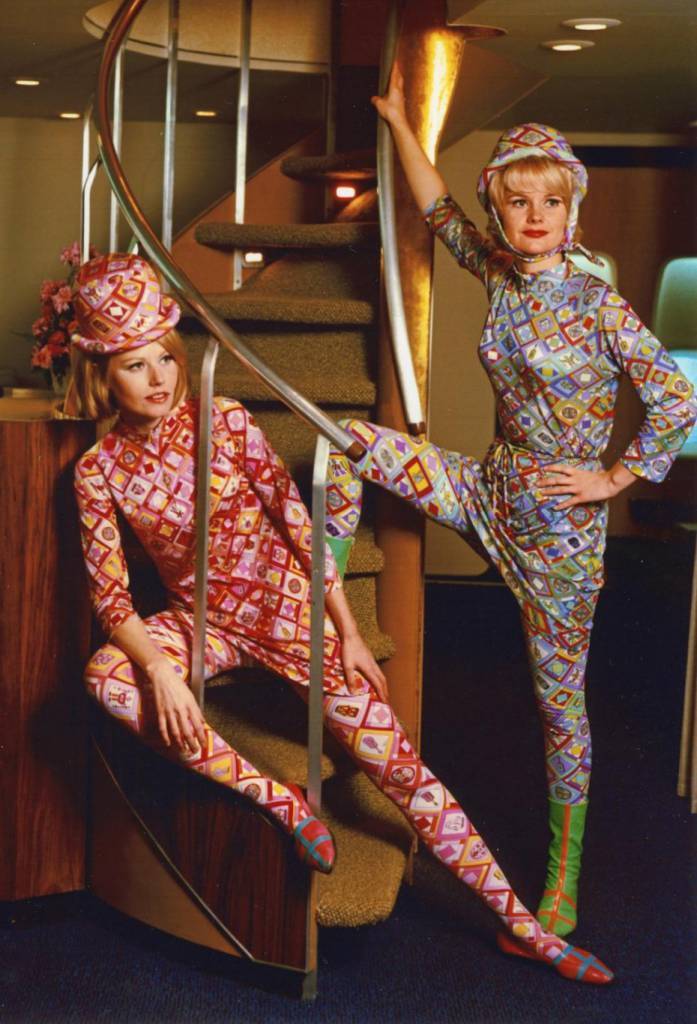 There had
been modest versions of Fashion Week
held in Milan since 1958, and the city was home
to a few well-respected Milan
designers, including Krizia, Mila Schön, and
Biki. Elio Fiorucci, at first an
importer of British mod
sportswear at the time of “Swinging London,”
opened his own boutique in Milan
in 1967, emphasizing casual, youthful fashion.
That was the same year the
Missoni family, based in Trieste, was invited to
show their collection at
Florence’s Pitti Palace art museum.
There had
been modest versions of Fashion Week
held in Milan since 1958, and the city was home
to a few well-respected Milan
designers, including Krizia, Mila Schön, and
Biki. Elio Fiorucci, at first an
importer of British mod
sportswear at the time of “Swinging London,”
opened his own boutique in Milan
in 1967, emphasizing casual, youthful fashion.
That was the same year the
Missoni family, based in Trieste, was invited to
show their collection at
Florence’s Pitti Palace art museum.
That show caused a sensation,
though as a succés
de scandale. Just before the show was to go on,
Rosita Missoni, the company’s
co-founder, noticed that the brassieres her
models were wearing were the wrong
color under her exquisitely thin knit dresses,
so she told them to discard
them (right). Owing
to the
near-transparency of the fabric and the lighting
in the palazzo, the women’s
sleek nudity showed through, to many viewers’
delight and to others’ sheer
horror. They
saw . . . nipples!
The Missonis were not asked back to the Pitti
the following year.
That began a slow exodus from
Florence to
Milan. The Missonis and many of  the Italian men’s wear designers
moved to the
city while Krizia relocated to a 16th century
palazzo in the city and shifted
her shows there. And they all began mounting
fashion shows with a distinctive
theatrical flair and Italian brio.
The press dubbed the shows “happenings,”
and, because there was no
official venue like the Pitti in Florence, the
Milan shows popped up all over
town, especially in the posh hotels like the
Principe di Savoia and the
Palace. Music
of the moment—including
the soundtrack from the movie “Star Wars” at one
show—boomed over crowds that
might include a thousand store buyers—a number
never known to attend shows in
Florence or Rome.
the Italian men’s wear designers
moved to the
city while Krizia relocated to a 16th century
palazzo in the city and shifted
her shows there. And they all began mounting
fashion shows with a distinctive
theatrical flair and Italian brio.
The press dubbed the shows “happenings,”
and, because there was no
official venue like the Pitti in Florence, the
Milan shows popped up all over
town, especially in the posh hotels like the
Principe di Savoia and the
Palace. Music
of the moment—including
the soundtrack from the movie “Star Wars” at one
show—boomed over crowds that
might include a thousand store buyers—a number
never known to attend shows in
Florence or Rome.
By the late 1970s, the
success of these shows,
based not so much on couture as on
ready-to-wear, quickly engaged interest from
Milan-based banks, whose lenders saw far more
potential in selling tens of
thousands of suits, dresses and sportswear
everywhere, rather than in selling
couture to a few hundred rich women around the
world.
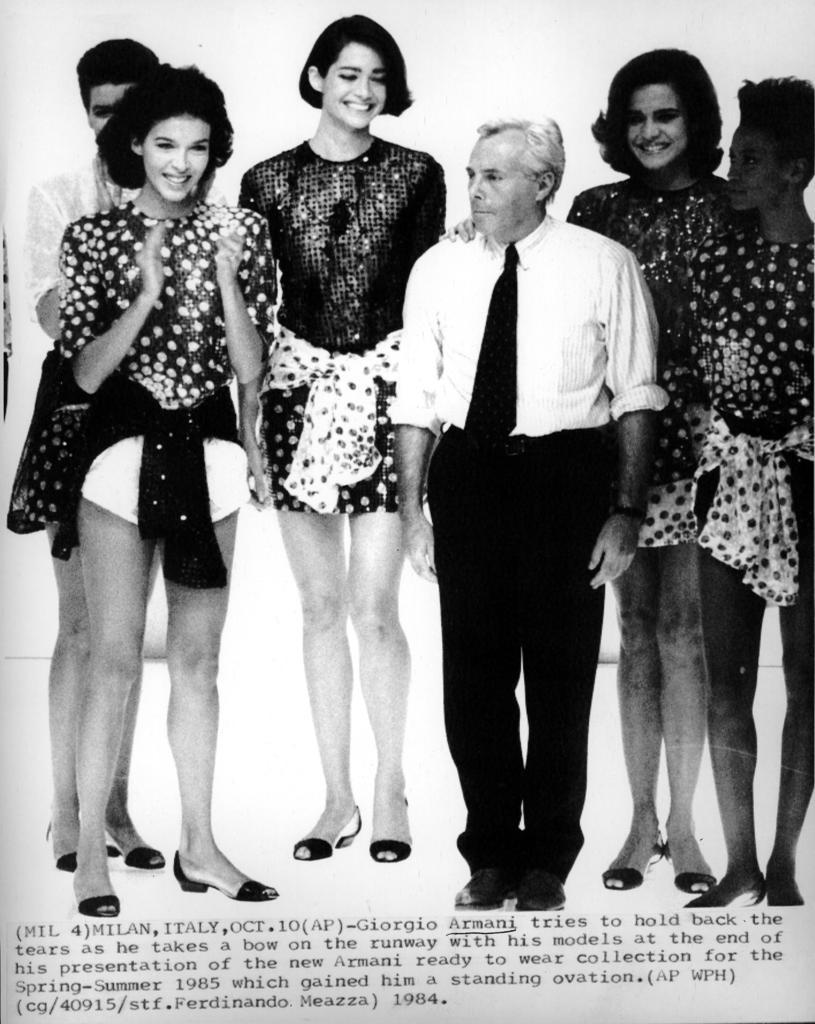 In
1977 The
New York Times’ fashion
critic Carrie Donovan pronounced the city “a
fashion capital rivaling Paris and
New York.”
Investors sought out
young designers on the verge of breaking
through, and none was readier than
Giorgio Armani to make a transformative splash
in the international fashion
market.
In
1977 The
New York Times’ fashion
critic Carrie Donovan pronounced the city “a
fashion capital rivaling Paris and
New York.”
Investors sought out
young designers on the verge of breaking
through, and none was readier than
Giorgio Armani to make a transformative splash
in the international fashion
market.
Armani (left)—the
name came via his father, who was
half Albanian—was born in Piacenza, a town in
Emilia-Romagna, and he had once
been a window-dresser at La Rinascente
department store in Milan, before
becoming an acolyte of Nino Cerruti.
Persuaded he could go out on his own, the
40-year-old Armani set up shop
in Milan on the Corso Venezia, at first
designing for other houses and winning
applause for shows with which he was involved at
the Pitti.
He
first
showed his own ready-to-wear and women’s lines
to overwhelming praise in
1975, and by the 1980s there were a perfume and
an underwear line, then the
Emporio Armani store in Milan. By
then everything was conceived and marketed from
his 19th century palazzo on the
centrally located Via Borgonuovo, where he lived
and worked—when he was not
relaxing at his villa outside of town, his
farmhouse in Forte dei Marmi, or his
hideaway on the remote island of Pantelleria.
Armani’s store, on Via San Andrea, was
antagonistically devoid of classic Milanese
trappings: the floors were rubber
matting, the walls translucent acrylic held up
by steel girders; track lights
brought everything in the store to life.
And prices were kept to a moderate
level—an Armani blazer sold for just
$330 at the store, half what it was in the
United States.
Having built up the most enviable
reputation and clientele of any
Italian designer—even appearing on the cover of
Time magazine—Armani didn’t even
hold runway shows for two years in
the early ‘80s, so there was a well-stoked fire
of intense interest as to what
his next show would be like.
For his menswear show, held earlier, in
January, Armani put up a huge
billboard to announce his lower priced Emporio
Armani men’s line. He bought magazine ads
showing an
androgynous-looking Charlotte Rampling dressed
in jackets in stripes and checks
that hinted at what was to come in the women’s
shows. By then, Armani’s annual
sales were soaring upwards to $100
million, and the new show was intended to be a
blockbuster among other Milan
extravaganzas.
And
Catherine and Nicola had passes for it!
Milan Fashion
Week,
which ran after the London and before the Paris
shows, began
in earnest on Monday, with
truckloads of clothes 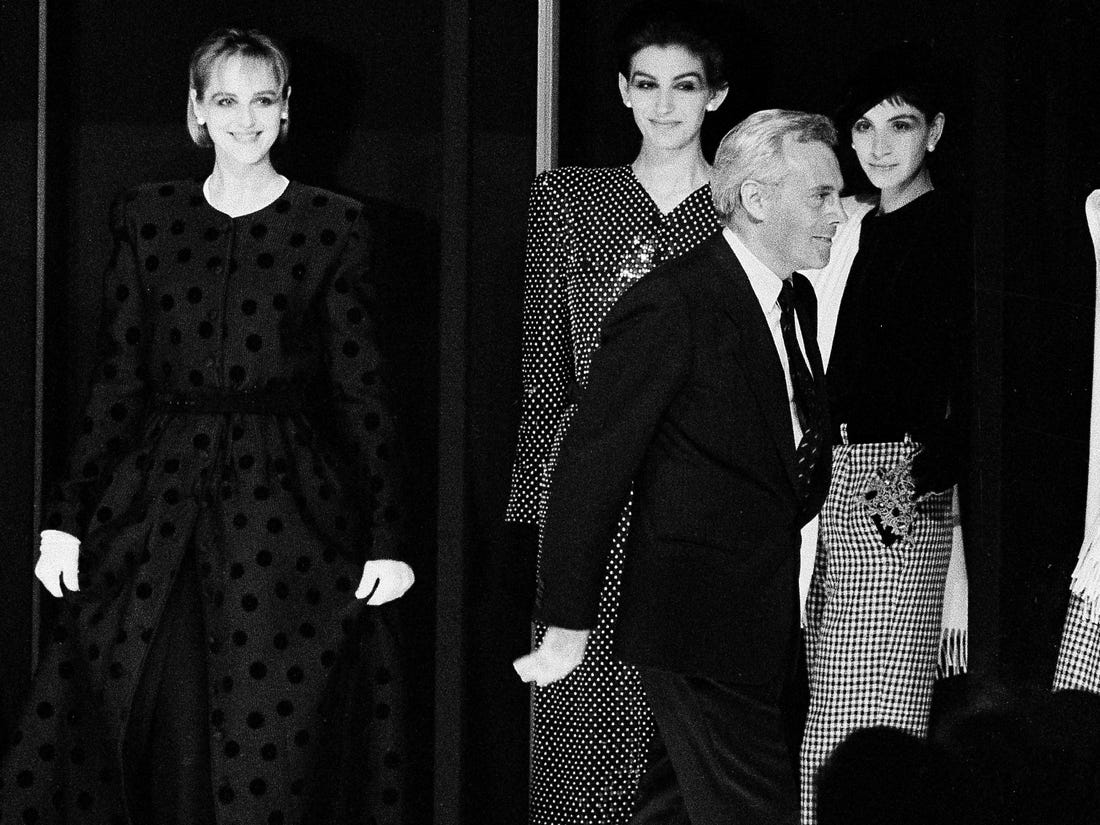 shipped into the city
days before and every hotel room
booked weeks prior. Limousine
drivers made more money in that one week than
they did all season, many of them
hired on-call twenty-four hours a day, moving
their impatient passengers slowly
through or around what was called the Golden
Triangle—the cobbled streets
of Via della Spiga, Via Sant'Andrea and Via
Montenapoleone.
shipped into the city
days before and every hotel room
booked weeks prior. Limousine
drivers made more money in that one week than
they did all season, many of them
hired on-call twenty-four hours a day, moving
their impatient passengers slowly
through or around what was called the Golden
Triangle—the cobbled streets
of Via della Spiga, Via Sant'Andrea and Via
Montenapoleone.
Both the
choreographed
and the wholly unplanned madness of Fashion
Week, all avidly reported on by the
Italian press and dutifully covered by their
bemused European and American
colleagues, was, of course, much about the
pecking order: who would be seated
in the front rows, who would be the first to
interview the top and the new
designers; who would be invited to the most
coveted parties; and who would get
the “A” tables at the city’s most fashionable
restaurants, where the designers’
marketing people entertained buyers and buyers
entertained clients.
The
frenzy of merely getting into the shows was
astonishing to Nicola and
Catherine, largely because Italians had a long
tradition of never paying any
attention to orderly lines, preferring instead
just to assemble in a slowly
moving mass, in these cases a very well- dressed
mass, as were the two American
girls in their new outfits.
Catherine had been to fashion
shows in New
York, but these were much less structured, the
music completely different—more
American rock and roll than Italian disco, thank
God—and the atmosphere far
more entertaining than commercial.
Armani’s show was, as usual, held at his
office-and-residence in a
basement that had once served as a bomb shelter,
which he had reconfigured as a
theater. Nicola
and Catherine were
suitably dazzled by it all, astonished when they
were shown to seats just four
rows from the runway.
“I think I’m going to faint
from all this
perfume around us,” said Nicola, aromatically
assaulted on all sides by
conflicting scents that included plenty of the
new Armani, which had just been
introduced to coincide with his show.
“I know,” said Catherine,
blinking.
“You could go out of the house without
any perfume and just brush up against some of
these women and absorb theirs.”
The
girls then began taking note of the few
famous people they could identify, like the
fashion editor from Vogue,
Grace Mirabella, with her
short-cropped blonde hair, and Carrie Donovan of
the Times, famous for her
ridiculously large black-rimmed glasses that
made her look as if she were always taking an
eye test.
But most of the first-row people were
unknown to Nicola and Catherine, who said, “Most
of them are probably buyers
from, like, Bloomingdale’s, Bergdorf’s and
Saks.”
There were also a lot of very
well-dressed men
at the show, some in Armani. When
Nicola nodded in the direction of one or
another, Catherine just shook her head
and said, “Forget it, they’re all gay.”
“I doubt they’re all gay,” said Nicola.
“Well, if they aren’t, they
are either fat
buyers or rich guys just here to pick up the new
models.”
“Hm,” said Nicola, then,
noticing an extremely
handsome, impeccably dressed man with slightly
long hair standing off near the
door, asked, “What about him?”
“Oh God, he’s gorgeous!” said Catherine, her jaw
dropping. “I don't know, he
doesn’t look gay. Maybe he’s a bouncer.”
Nicola laughed, “That guy is
not a
bouncer. All the bouncers are
wearing the same outfit, over there, the muscle
heads in the black t-shirts and
jeans.”
But at that moment the
gorgeous man they’d been
discussing was saying goodbye to a woman with a
clipboard and earphones, He kissed
her on both cheeks and was out the door.
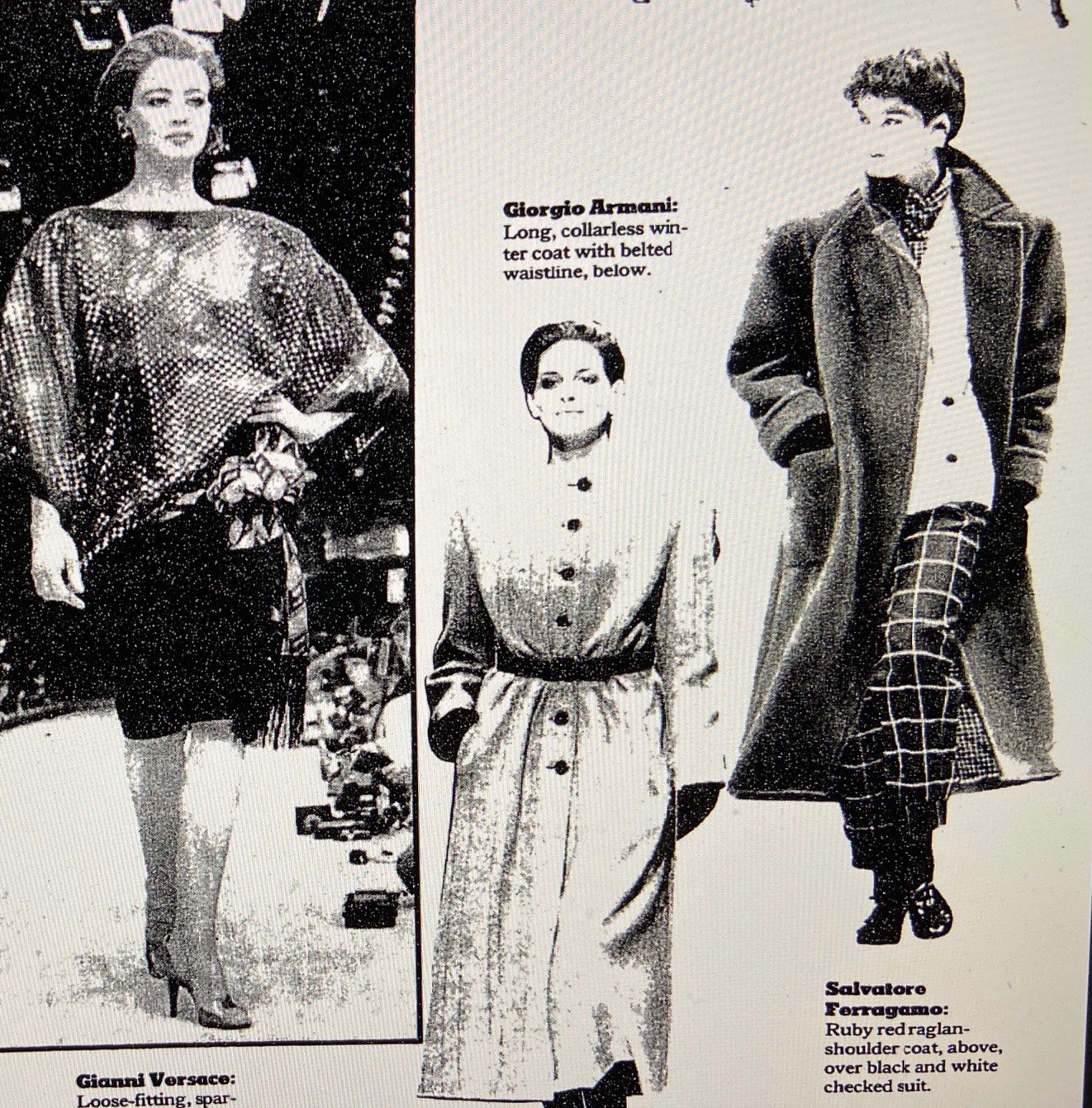 Nicola
sighed, “Well, guess we’ll never know.
Nicola
sighed, “Well, guess we’ll never know.
And
so it began, with a parade of models sashaying
down the catwalk in the
provocative, exaggerated way Catherine and
Nicola had mocked on their way over—which
had gotten them a couple of comments and wolf
whistles.
This was Armani’s tenth
women’s line, and the clothes had the flow and
caress of fabrics that seemed
only he could somehow obtain: the patterned
silks and the subtle woolen weaves,
the muted but true colors of taupe, gray, brown
and black.
Nicola, even from the fourth row, could
tell that what lay behind the flow and drape of
such fabrics seemingly so
unconstructed was in fact due to the kind of
exacting and exquisite tailoring
that had long distinguished Italian fashion and
showed the true artfulness of
the Armani style.
Like the
undercoatings and build-up of colors in
Renaissance paintings, Armani’s genius
was hidden beneath the exterior beauty of his
clothes. Sprezzatura,
after enormous hard work.
There
were many jackets—the article of clothing on
which Armani had
built his reputation—some short, some long, some
in black velvet, gathered at
the waist rather than hanging free; skirts were
above the knee and tight across
the hips or bouffant, flared by petticoats;
slacks fit like ski pants, with
foot straps; coats dropped to the ankle; tunics
were crafted from lace.
What
struck Nicola and Catherine most was that
the clothes were so clearly, so remarkably,
adapted to what a woman in 1986 could
actually wear, rather than the extreme gimmickry
of so much haute couture. Right
then and there most of the women
in the audience wanted to rip the clothes from
the models’ bodies and
immediately put them on to wear outside, to go
to work in, socialize in, even
fall asleep in, knowing that the fabrics would
look as fresh and unwrinkled the
next day as the night before.
After
successive struts down the runway, the willowy,
never smiling models stopped
appearing. “Well, the show looks like it’s
over,” said Catherine. “Let’s get out of here
before everyone
gets up.”
At
that, on the two-tier stage, each model
emerged for the last time from individual
cubicles, followed by a
sheepish-looking, bleary-eyed Giorgio Armani in
his black t-shirt and jeans. He
was applauded and greeted with successive waves
of bravos as the models
discreetly patted their slender hands together,
almost in unison.
By Geoff Kalish
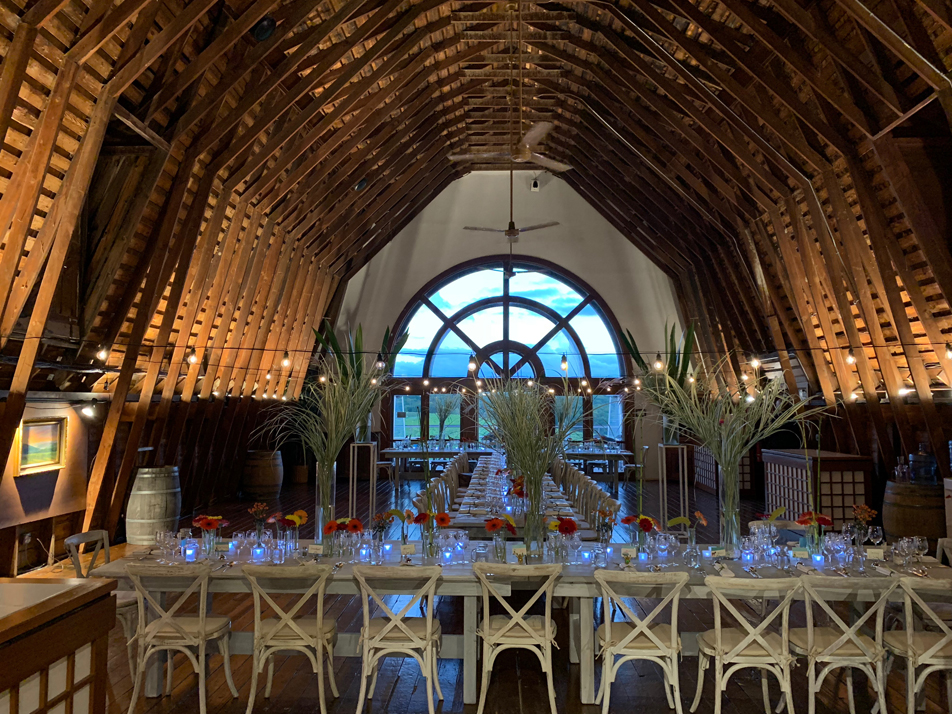
Sitting on
a scenic Hudson Valley hill overlooking vineyards
and 3 ponds (manmade to moderate the surrounding
temperature), Millbrook Winery was founded in 1981
by former New York State Commissioner of
Agriculture John Dyson (left) and his brother-in-law,
David Bova. It was the first Hudson Valley winery
to produce wines only from vitis
vinifera grapes—classic European varietals,
as opposed to hybrid grapes used at the time by
other facilities. (Of note, Dyson was also
instrumental in the 1976 passage of New York
State’s Farm Winery Law, allowing farmers to make
and sell wine for only a small licensing fee,
thereby encouraging numerous small wineries
throughout the state.) And managed now primarily by
Mr. Bova and winemaker John Graziano, Millbrook
Winery produces approximately 15,000 cases of wine
annually.
 Since it’s less than a
two-hour car ride from New York City and a popular
outing spot for tourists from the nearby counties
(especially Westchester), in the past the winery
was bustling on weekends, with tours and tastings,
and numerous special events as well as lunch
served on an outdoor terrace overlooking the
grounds. Also, in addition to sales of bottles at
the winery, wholesale sales to local restaurants
and retail shops in the area as well as in
Westchester County and New York City was brisk.
Obviously, with the COVID-19 pandemic, that’s
changed now and to gain some insight into the
future of Millbrook and other Hudson Valley
Wineries, I spoke to Bova. Some of his comments
follow:
Since it’s less than a
two-hour car ride from New York City and a popular
outing spot for tourists from the nearby counties
(especially Westchester), in the past the winery
was bustling on weekends, with tours and tastings,
and numerous special events as well as lunch
served on an outdoor terrace overlooking the
grounds. Also, in addition to sales of bottles at
the winery, wholesale sales to local restaurants
and retail shops in the area as well as in
Westchester County and New York City was brisk.
Obviously, with the COVID-19 pandemic, that’s
changed now and to gain some insight into the
future of Millbrook and other Hudson Valley
Wineries, I spoke to Bova. Some of his comments
follow: 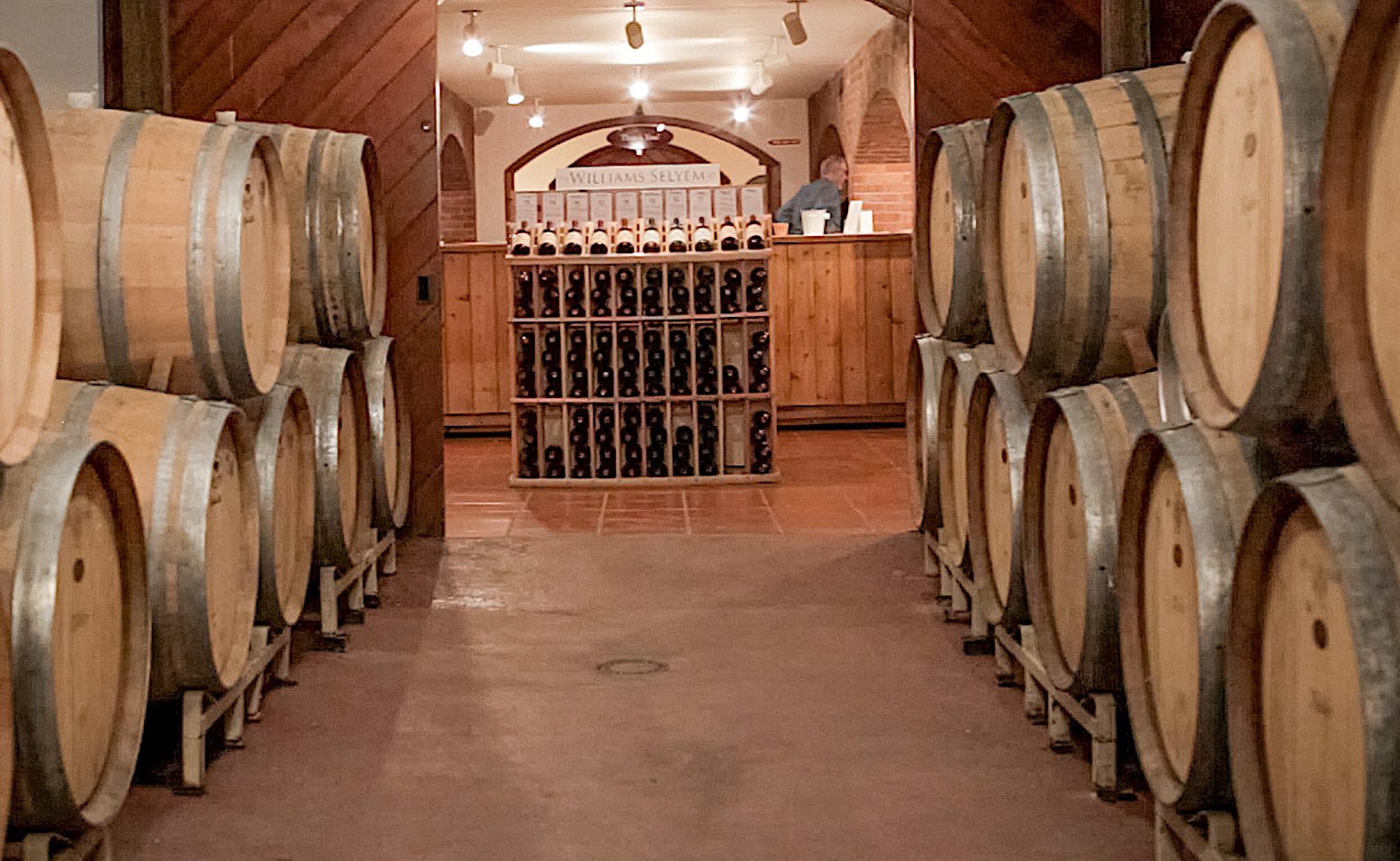 “The key to our financial
success over the last many years has been selling
wine directly out the front door of the winery.
And last year we saw over 25,000 visitors to the
winery to taste wine, come to our Food Truck
Friday events or a Jazz concert on Saturday
evening. Of course, that is before COVID hit.
However, if Millbrook’s local support during this
COVID crisis is any indication, I believe there is
a great future for Hudson Valley wineries. While
our Tasting Room is open for pick-up only, without
tours or tastings taking place, out
Direct-to-Consumer sales are up over 200%. These
are from customers who want our wine and call in
to get it directly. In fact, we are thrilled that
our core customers are still supporting us even if
they can’t come here and taste with us. Actually,
I believe Millbrook’s long tenure (celebrating our
35th vintage this year) is very helpful. Of
course, and more importantly, the wines produced
by John Graziano (our only winemaker) have gotten
better over the years, so we have a solid track
record and reputation for producing high quality
wines.”
“The key to our financial
success over the last many years has been selling
wine directly out the front door of the winery.
And last year we saw over 25,000 visitors to the
winery to taste wine, come to our Food Truck
Friday events or a Jazz concert on Saturday
evening. Of course, that is before COVID hit.
However, if Millbrook’s local support during this
COVID crisis is any indication, I believe there is
a great future for Hudson Valley wineries. While
our Tasting Room is open for pick-up only, without
tours or tastings taking place, out
Direct-to-Consumer sales are up over 200%. These
are from customers who want our wine and call in
to get it directly. In fact, we are thrilled that
our core customers are still supporting us even if
they can’t come here and taste with us. Actually,
I believe Millbrook’s long tenure (celebrating our
35th vintage this year) is very helpful. Of
course, and more importantly, the wines produced
by John Graziano (our only winemaker) have gotten
better over the years, so we have a solid track
record and reputation for producing high quality
wines.”
To
follow-up on Bova’s comments I recently took a
ride to the winery for curb-side pick-up and
purchased bottles representative of the current
releases and the following comments are based on
tasting these as well as an “oldie” from my
cellar. (All prices provided are suggested retail
cost for 750ml bottles. Of note, there’s a 15%
discount for bottles purchased at the winery)
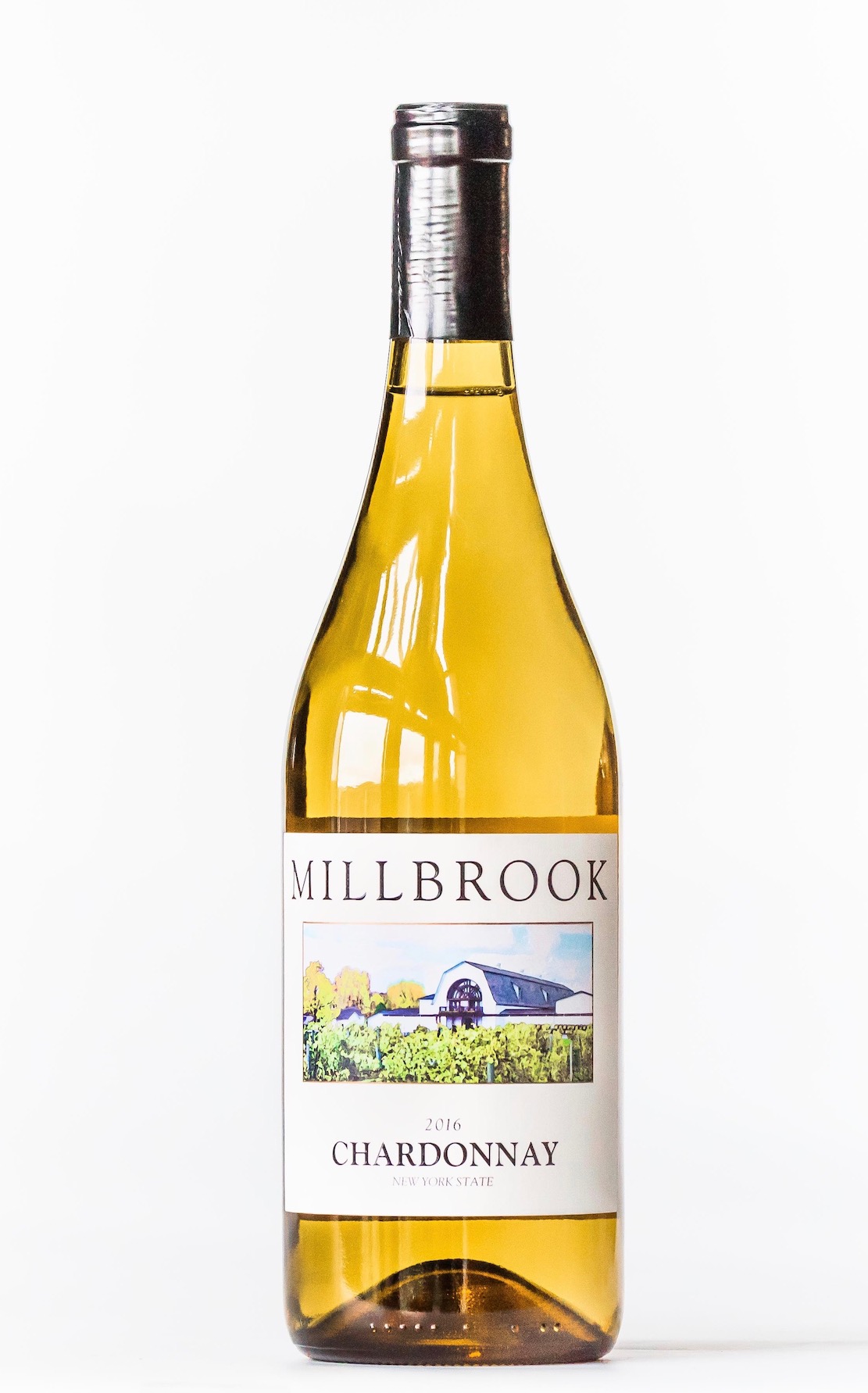 2018
Millbrook Chardonnay ($18.50). Made
from grapes grown in a variety of New York State
locales, following fermentation 50% of this wine
was aged in oak for 7 months. It shows a bouquet
and taste of ripe apples and lemon and a crisp
finish with notes of vanilla and anise. Mate it
with roasted chicken or turkey as well as grilled
branzino or orata.
2018
Millbrook Chardonnay ($18.50). Made
from grapes grown in a variety of New York State
locales, following fermentation 50% of this wine
was aged in oak for 7 months. It shows a bouquet
and taste of ripe apples and lemon and a crisp
finish with notes of vanilla and anise. Mate it
with roasted chicken or turkey as well as grilled
branzino or orata.
2019 Millbrook
Unoaked Chardonnay ($18.50). Produced
in the style of a French Chablis, this wine has a
bouquet and taste of apples and citrus with a
refreshing lemony finish. It marries well with
scallops, grilled trout or shrimp.
2018 Millbrook
Proprietor’s Special Reserve ($25). Similar
in style to a top-flight Napa Chardonnay, this
elegant barrel-fermented wine, from estate grown
Hudson Valley grapes, is loaded with flavors of
ripe apples, citrus and vanilla with a long smooth
finish. It makes ideal accompaniment to 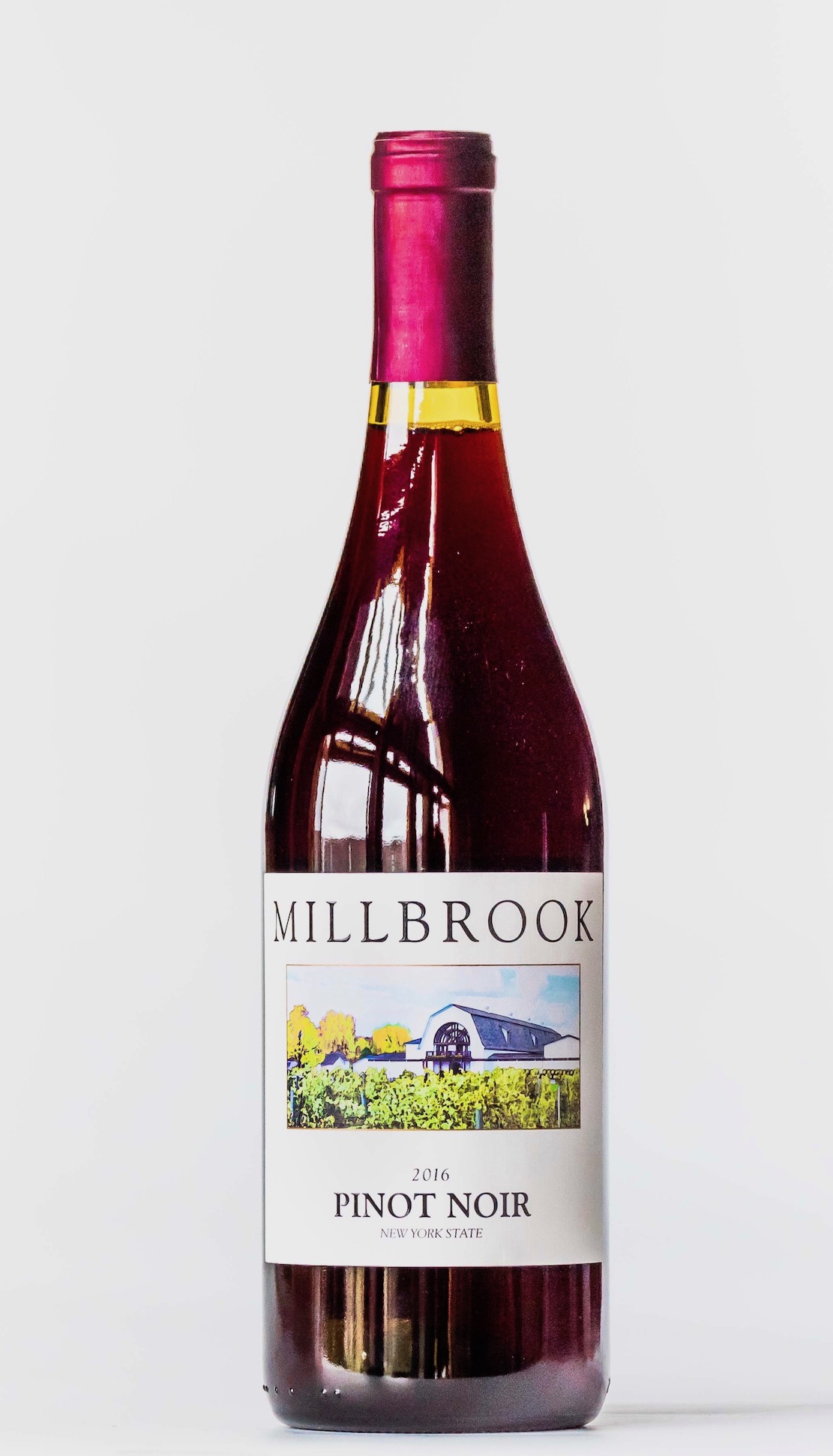 halibut, grilled tuna,
even swordfish.
halibut, grilled tuna,
even swordfish.
2018 Millbrook
Proprietor’s Special Reserve Tocai Fruilano
($18). Made
from Hudson Valley estate grown grapes, this
varietal is usually associated with wines from
northeastern Italy. However, one would be hard
pressed to find it dissimilar from its Italian
cousin, showing a bouquet and flavors of ripe
pears, gooseberries and lime, with a touch of
almonds in its soft finish. Try it with mahi mahi,
cobia, turkey or even grilled pork chops.
2018 Millbrook Pinot
Noir ($23). This
barrel-aged, 100% Pinot Noir, with grapes hailing
from across New York State, has a bouquet and
taste of ripe plums, cranberry and notes of cherry
in its finish. It matches well with grilled
salmon, Artic char or roasted turkey, as well as
pasta with red sauce.
2018 Millbrook
Cabernet Franc ($23). Produced
from a blend of 79% Cabernet Franc, 9% Malbec and
2% Merlot grapes from the Millbrook estate as well
as other prime growing areas in New York State,
this wine was barrel-aged for 11 months prior to
bottling. It shows a bouquet and taste of ripe
raspberries and cassis with a long, smooth finish
with a touch of tannin. Mate it with grilled
steak, lamb or pork roasts as well as hamburgers
and pizza.
1986 Millbrook Claret
($14 when originally purchased in 1988)—Made
from a blend of Merlot (65%), Cabernet Sauvignon
(25%) and 10% other varietals, this wine has a
bouquet and flavor akin to an elegant, aged right
bank Bordeaux, with a scent of violets and a taste
of black truffles and chocolate with still a bit
of tannin in its finish. We enjoyed it with
grilled skirt steak and baked acorn squash.
Sponsored by

Any of John Mariani's books below may be ordered from amazon.com.
 The Hound in Heaven
(21st Century Lion Books) is a novella, and
for anyone who loves dogs, Christmas, romance,
inspiration, even the supernatural, I hope you'll find
this to be a treasured favorite. The story
concerns how, after a New England teacher, his wife and
their two daughters adopt a stray puppy found in their
barn in northern Maine, their lives seem full of promise.
But when tragedy strikes, their wonderful dog Lazarus and
the spirit of Christmas are the only things that may bring
his master back from the edge of despair.
The Hound in Heaven
(21st Century Lion Books) is a novella, and
for anyone who loves dogs, Christmas, romance,
inspiration, even the supernatural, I hope you'll find
this to be a treasured favorite. The story
concerns how, after a New England teacher, his wife and
their two daughters adopt a stray puppy found in their
barn in northern Maine, their lives seem full of promise.
But when tragedy strikes, their wonderful dog Lazarus and
the spirit of Christmas are the only things that may bring
his master back from the edge of despair. WATCH THE VIDEO!
“What a huge surprise turn this story took! I was completely stunned! I truly enjoyed this book and its message.” – Actress Ali MacGraw
“He had me at Page One. The amount of heart, human insight, soul searching, and deft literary strength that John Mariani pours into this airtight novella is vertigo-inducing. Perhaps ‘wow’ would be the best comment.” – James Dalessandro, author of Bohemian Heart and 1906.
“John Mariani’s Hound in Heaven starts with a well-painted portrayal of an American family, along with the requisite dog. A surprise event flips the action of the novel and captures us for a voyage leading to a hopeful and heart-warming message. A page turning, one sitting read, it’s the perfect antidote for the winter and promotion of holiday celebration.” – Ann Pearlman, author of The Christmas Cookie Club and A Gift for my Sister.
“John Mariani’s concise, achingly beautiful novella pulls a literary rabbit out of a hat – a mash-up of the cosmic and the intimate, the tragic and the heart-warming – a Christmas tale for all ages, and all faiths. Read it to your children, read it to yourself… but read it. Early and often. Highly recommended.” – Jay Bonansinga, New York Times bestselling author of Pinkerton’s War, The Sinking of The Eastland, and The Walking Dead: The Road To Woodbury.
“Amazing things happen when you open your heart to an animal. The Hound in Heaven delivers a powerful story of healing that is forged in the spiritual relationship between a man and his best friend. The book brings a message of hope that can enrich our images of family, love, and loss.” – Dr. Barbara Royal, author of The Royal Treatment.
 |
The Encyclopedia of American Food and Drink by John F. Mariani (Bloomsbury USA, $35) Modesty forbids me to praise my own new book, but let me proudly say that it is an extensive revision of the 4th edition that appeared more than a decade ago, before locavores, molecular cuisine, modernist cuisine, the Food Network and so much more, now included. Word origins have been completely updated, as have per capita consumption and production stats. Most important, for the first time since publication in the 1980s, the book includes more than 100 biographies of Americans who have changed the way we cook, eat and drink -- from Fannie Farmer and Julia Child to Robert Mondavi and Thomas Keller. "This book is amazing! It has entries for everything from `abalone' to `zwieback,' plus more than 500 recipes for classic American dishes and drinks."--Devra First, The Boston Globe. "Much needed in any kitchen library."--Bon Appetit. |
"Eating Italian will never be the same after reading John Mariani's entertaining and savory gastronomical history of the cuisine of Italy and how it won over appetites worldwide. . . . This book is such a tasteful narrative that it will literally make you hungry for Italian food and arouse your appetite for gastronomical history."--Don Oldenburg, USA Today. "Italian
restaurants--some good, some glitzy--far
outnumber their French rivals. Many of
these establishments are zestfully described
in How Italian Food Conquered the World, an
entertaining and fact-filled chronicle by
food-and-wine correspondent John F.
Mariani."--Aram Bakshian Jr., Wall Street
Journal.
"Equal parts
history, sociology, gastronomy, and just
plain fun, How Italian Food Conquered the
World tells the captivating and delicious
story of the (let's face it) everybody's
favorite cuisine with clarity, verve and
more than one surprise."--Colman Andrews,
editorial director of The Daily
Meal.com. "A fantastic and fascinating
read, covering everything from the influence
of Venice's spice trade to the impact of
Italian immigrants in America and the
evolution of alta cucina. This book will
serve as a terrific resource to anyone
interested in the real story of Italian
food."--Mary Ann Esposito, host of PBS-TV's
Ciao
Italia. "John Mariani has written the
definitive history of how Italians won their
way into our hearts, minds, and
stomachs. It's a story of pleasure over
pomp and taste over technique."--Danny Meyer,
owner of NYC restaurants Union Square
Cafe, The Modern, and Maialino.
|
 |
 |
 |
 |
 |
 |
 |
 |
 Everett Potter's Travel Report:
Everett Potter's Travel Report: 
 Eating Las Vegas
JOHN CURTAS has been covering the Las Vegas
food and restaurant scene since 1995. He is
the co-author of EATING LAS VEGAS – The 50
Essential Restaurants (as well as
the author of the Eating Las Vegas web site: www.eatinglasvegas.
He can also be seen every Friday morning as
the “resident foodie” for Wake Up With the
Wagners on KSNV TV (NBC) Channel 3 in
Las Vegas.
Eating Las Vegas
JOHN CURTAS has been covering the Las Vegas
food and restaurant scene since 1995. He is
the co-author of EATING LAS VEGAS – The 50
Essential Restaurants (as well as
the author of the Eating Las Vegas web site: www.eatinglasvegas.
He can also be seen every Friday morning as
the “resident foodie” for Wake Up With the
Wagners on KSNV TV (NBC) Channel 3 in
Las Vegas.
MARIANI'S VIRTUAL GOURMET
NEWSLETTER is published weekly. Publisher: John Mariani. Editor: Walter Bagley. Contributing Writers: Christopher Mariani,
Robert Mariani, Misha Mariani, John A. Curtas, Gerry Dawes, Geoff Kalish,
and Brian Freedman. Contributing
Photographer: Galina Dargery. Technical
Advisor: Gerry
McLoughlin.
If you wish to subscribe to this
newsletter, please click here: http://www.johnmariani.com/subscribe/index.html
© copyright John Mariani 2020
